ASRock Fatal1ty Z77 Professional Review - IDE and Floppy on Z77
by Ian Cutress on May 20, 2012 1:30 PM EST- Posted in
- Motherboards
- ASRock
- Fatal1ty
- Z77
Test Setup
| Processor |
Intel Core i7-3770K ES 4 Cores, 8 Threads, 3.5 GHz (3.9 GHz Turbo) |
| Motherboards |
ASRock Z77 Extreme4 ASUS P8Z77-V Pro Gigabyte GA-Z77X-UD3H MSI Z77A-GD65 ASUS P8Z77-V Deluxe ASRock Fatal1ty Z77 Professional |
| Cooling | Intel All-in-One Liquid Cooler |
| Power Supply | OCZ 1250W Gold ZX Series |
| Memory |
GSkill RipjawsZ 4x4 GB DDR3-2400 9-11-11 Kit GSkill TridentX 2x4 GB DDR3-2666 11-13-13 Kit |
| Memory Settings | XMP (2400 9-11-11) |
| Video Cards |
ASUS HD7970 3GB ECS GTX 580 1536MB |
| Video Drivers |
Catalyst 12.3 NVIDIA Drivers 296.10 WHQL |
| Hard Drive | Micron RealSSD C300 256GB |
| Optical Drive | LG GH22NS50 |
| Case | Open Test Bed - CoolerMaster Lab V1.0 |
| Operating System | Windows 7 64-bit |
| SATA Testing | Micron RealSSD C300 256GB |
| USB 2/3 Testing | OCZ Vertex 3 240GB with SATA->USB Adaptor |
Power Consumption
Power consumption was tested on the system as a whole with a wall meter connected to the OCZ 1250W power supply, while in a dual 7970 GPU configuration. This power supply is Gold rated, and as I am in the UK on a 230-240 V supply, leads to ~75% efficiency > 50W, and 90%+ efficiency at 250W, which is suitable for both idle and multi-GPU loading. This method of power reading allows us to compare the power management of the UEFI and the board to supply components with power under load, and includes typical PSU losses due to efficiency. These are the real world values that consumers may expect from a typical system (minus the monitor) using this motherboard.
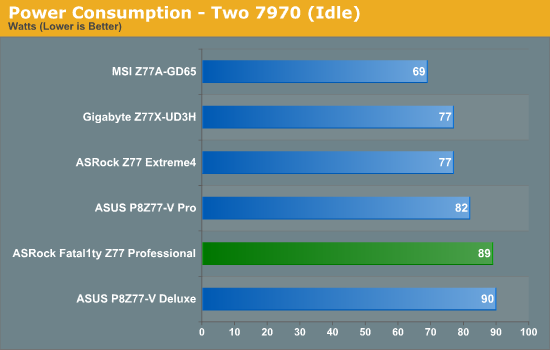
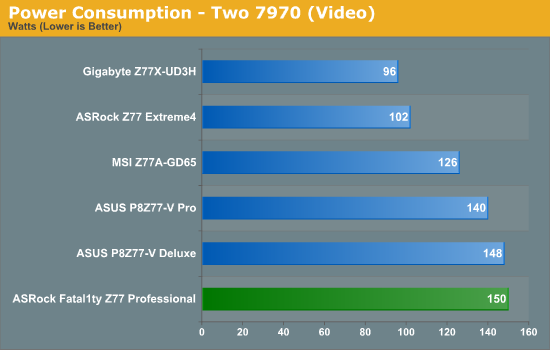
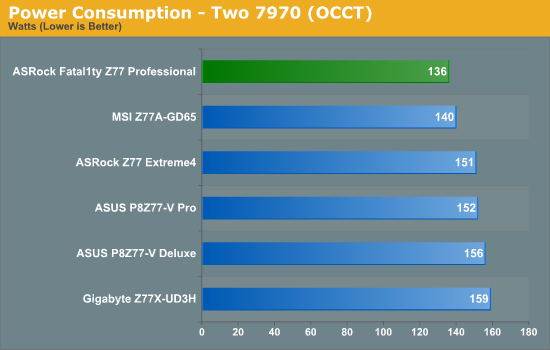
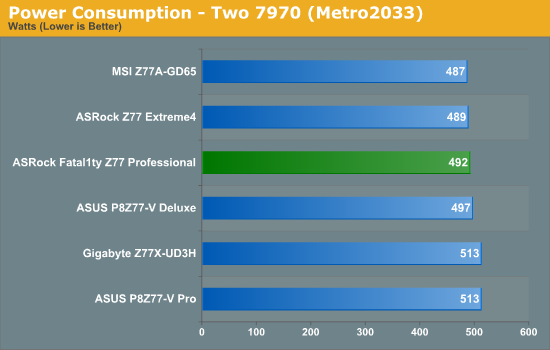
A trend I have noticed over the course of Ivy Bridge testing is that the more power phases there are on a board, the more of the phases are ‘loaded’ during moderate CPU usage, such as playing video. As these phases are at low loading individually, they are relatively inefficient than compared to high loading – this leads to a lot of power draw. As the ASRock Fatal1ty Z77 Professional has a 16+8 phase power delivery, we see this explicitly with 150W system power draw at load – 48W more than the ASRock Z77 Extreme4. There could also be other reasons for this difference, such as different signals to the GPUs regarding power required and how they power gate certain features.
POST Time
Different motherboards have different POST sequences before an operating system is initialized. A lot of this is dependent on the board itself, and POST boot time is determined by the controllers on board (and the sequence of how those extras are organized). As part of our testing, we are now going to look at the POST Boot Time - this is the time from pressing the ON button on the computer to when Windows starts loading. (We discount Windows loading as it is highly variable given Windows specific features.) These results are subject to human error, so please allow +/- 1 second in these results. As requested in my initial Z77 review, we will also be showcasing normal and ‘stripped’ POST times, whereby controllers are turned off in an attempt to get the minimum POST time.
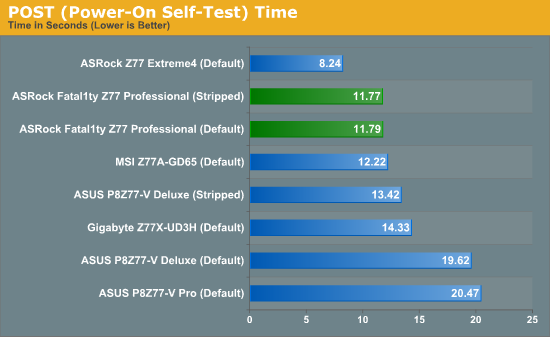
Overall, ASRock are posting some rather reasonable POST times, coming in at almost half the time of the slowest boards. It seems that the controllers on board have little effect on the POST time itself, as the stripped time comes in almost exactly the same as the default time.
Overclocks
Here at AnandTech we want to provide quick and easy ways to determine if a board is good for you (with in-depth analysis of course). So here is a quick round up of our overclocking results. Overclocks are tested for stability with PovRay and OCCT - while these may not be the most strenuous of stability tests, it does offer a quick check for memory errors under high load (and also balances testing time with getting the next board on for review!).
|
CPU Speed (MHz) |
Voltage (Volts) |
PovRay Peak Temp (ºC) |
OCCT Peak Temp (ºC) |
Notes | |
|
ASRock Fatal1ty Z77 Professional |
4700 | 1.200 | 89 | 89 | PLL Overvoltage enabled |
|
ASRock Z77 Extreme4 |
4700 | 1.175 | 86 | 86 | LLC Level 1 |
|
ASUS P8Z77-V Deluxe |
4700 | 1.225 | 89 | 84 | PLL Overvoltage enabled |
|
ASUS P8Z77-V Pro |
4700 | 1.200 | 83 | 86 | PLL Overvoltage enabled |
|
Gigabyte Z77X-UD3H |
4700 | 1.200 | 82 | 86 | LLC Extreme |
|
MSI Z77A-GD65 |
4700 | 1.250 | 90 | - | PLL Overvoltage enabled |










57 Comments
View All Comments
kevith - Monday, May 21, 2012 - link
Yeah, that struck me as well.scaramoosh - Sunday, May 20, 2012 - link
I wont buy anything branded by that loser who hasn't really competed since 2005.Iketh - Sunday, May 20, 2012 - link
someone sounds bitter lolhaters gonna hate!
Friendly0Fire - Monday, May 21, 2012 - link
I wouldn't call him a loser, but I too would rather like the Fatal1ty crap toned down a bit. I've never seen him play, I actually don't give a damn about him, so his likeness appearing on products that I otherwise could want to buy feels more like excessive branding than anything else.I can see why he's on them, of course: he did a lot of firsts and his nickname is marketable (it's got a bit of a "leetspeak" feel, which apparently appeals to a certain audience, it's "edgy" but still family-friendly, etc.). As much as I respect Starcraft players, I don't think NesTea or Stephano-branded hardware would sound good.
Reikon - Sunday, May 20, 2012 - link
I've always wondered if Fatal1ty branding actually convinced anyone to buy something. It usually just drives me away since it seems more like a branding gimmick for something that can't stand on its own.Camikazi - Monday, May 21, 2012 - link
That is like asking if Michael Jordan branded shoes, or Tony Hawk branded skateboard ever prompted someone to buy them. The answer is easy, OF COURSE IT DOES, there are always people who don't know enough about things that go for celeb branded items because the celebs endorsed it. They don't know or care enough to find out that there are cheaper parts that are as good or better out there they just want the name.Matt355 - Monday, May 21, 2012 - link
Thought I was the only one that felt that way.FozzyofAus - Sunday, May 20, 2012 - link
I also don't see the point of an IDE or Floppy port.How about a review of the uATX version of the board? I'm not convinced that many people really need a full ATX board anymore.
iamkyle - Sunday, May 20, 2012 - link
Seriously Jon? You "consultations" with manufacturers lead you to add long gone legacy floppy and IDE?Somebody PLEASE make me an enthusiast board with barebones I/O - USB only. Let me choose my NIC & my sound MYSELF. As a TRUE enthusiast would.
jabber - Monday, May 21, 2012 - link
Exactly a real hardcore gamers board would be stripped of everything not required to just get the PC up and running.Then you would have a board with the minimum of traces and junk on it for the best performance. No fat at all. Then add just the hardware you need and nothing else.